by
Larry Pearce
7/13/17
In the early twentieth century the authors of the comprehensive volume, A Brief History of Yost (Joseph) and Jeremiah Miller and their descendants, surprised their family and readers around the world by reporting that their unique history had not been formally written down prior to 1911. As with so many families, the persons, dates, and stories had been taken for granted. It was then that the account of the Miller historians had a portion of their research published in an area newspaper through the transcription of a speech given at a family reunion. William H. Miller had addressed a crowd of some 600 Miller descendants at a picnic in Somerset, Pennsylvania, On August 26, 1910. He said, “The fathers and grandfathers of the present generation had frequently talked of their ancestors, and they were known by family records, births and marriages noted in family bibles.” He also referred to court records and State archives going back to the time of the American Revolution. It was this speech, highlighted in that early newspaper account, that I used as the simple introduction to my wife Susan’s Joseph “Yost” Miller1 family on this webpage from the time is was first posted in 2011. While you can still read that article, today begins a new era in the history of the Miller family of Somerset County with the latest information we have on hand. In addition to the earlier speech and book, you’re invited to keep the Joseph Miller Family Tree handy for reference as well as the Vitals pages for multiple generations. Be reminded that while these Millers were all Lutherans from Germany, my wife’s maternal Somerset County ancestors include Anabaptist Millers from Switzerland. Their trees, vitals, and stories may be found under the Krause surname, but caution: some of the German Lutheran Millers and Swiss Anabaptist Millers intermarried over the years. Oh, and don’t forget Somerset County’s Englishmen like “Saucy Jack” Miller, probably no relation but an important part of local lore. We don’t know what church he attended, if any.
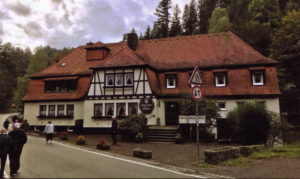
Klugschulemuhle at Trippstadt, Germany (c.1688), operated by the Christian Miller family (now a restaurant)
Joseph Miller, Sr., Yost’s father, was probably born in the Palatinate region of Germany. His family had survived the devastating Thirty Years War (1618-1648) to sail on the ship Barclay in September 1754 from via Rotterdam, Holland. They arrived in the port of Philadelphia and settled in Ephrata, a small town in northern Lancaster County.2 Historians estimate that nearly 100,000 Germans called Pennsylvania home before the Revolutionary War, many at the personal invitation of the William Penn family. Many were patriots, like our Millers, who militarily defended their new homeland. Some couldn’t because of their Anabaptist convictions. Still others, some 30,000 called “Hessians,” had been hired by the British monarchy to beat back the revolution. It is clear that our Millers, not unlike on America’s German front in World War II, may have faced friends, even family, on the battlefield who had come from the same region of the Old World.
Many public records have Joseph’s sons Yost and Jeremiah coming to Somerset County from Lancaster County.3 That’s about all we know of our early Miller family origins at this time, but research is continuing.4
Joseph Miller’s sons Yost and Jeremiah voluntarily signed up to defend the rights of the Colonies in the American Revolution which began in 1776. They each served in various companies.5 Brother Jeremiah apparently suffered for his service to the Colonies the most, having been wounded in the Battle of Long Island. He fought at Princeton and Germantown, but on September 11, 1777, he was taken prisoner in the Battle of Brandywine just south of Philadelphia. According to the Pennsylvania Archives, both Jeremiah and his wife Elizabeth “Betty”6 were captured by the British and taken across the Delaware River to Brunswick, NJ, where they eventually escaped. Jeremiah was honorably discharge on New Year’s Day 1778.
Yost Miller came west to Somerset County, which was then part of Bedford County, around 1784, after being discharged from the Army, marrying, and siring a son. As most frontier settlers, he and brother Jeremiah’s chief desire was to farm and raise a family. The first public record for brother Jermiah in the county is the purchase of land just to the west of modern day Somerset Boro in 1805.7 Though Lutherans, the Millers accompanied many Anabaptist Amish-Mennonites and Church of the Brethren who left eastern Pennsylvania for several reasons. Probably first and foremost was economic opportunity; they sought new and larger farms on the frontier that had been opened up after the Fort Stanwix Treaty of 1782.8 The younger generation that had fought in the Revolution were moving away from their parents to this new land, encouraged by the State to settle what once was the “hunting grounds” of the Native Americans. Some of the Anabaptists, who had pledged allegiance to the British monarchy in order to gain passage to America, soon felt a conflict when asked later to fight for the Colonies, so they came West. 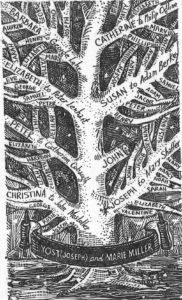 Yost Miller claimed land in what is now Quemahoning Township, in the eastern central part of Somerset County, it is believed, through the process of “Tomahawk Rights” or “Cabin Rights,” usually walking around as far as he could through the wilderness in a day and marking the boundaries with an ax. The house and barn were always located as close to a water source as possible. The area that these Millers settled is known today as Coleman’s Station, adjacent to the Long “plantation,” as farms were called back then. As we said earlier, the Longs had produced Yost’s wife, Anna Maria Catharina.9 But Yost did more than clear land and farm. He built the first saw mill in northern part of the county.
Yost Miller claimed land in what is now Quemahoning Township, in the eastern central part of Somerset County, it is believed, through the process of “Tomahawk Rights” or “Cabin Rights,” usually walking around as far as he could through the wilderness in a day and marking the boundaries with an ax. The house and barn were always located as close to a water source as possible. The area that these Millers settled is known today as Coleman’s Station, adjacent to the Long “plantation,” as farms were called back then. As we said earlier, the Longs had produced Yost’s wife, Anna Maria Catharina.9 But Yost did more than clear land and farm. He built the first saw mill in northern part of the county.
Yost Miller died in 1811, is buried on what today is known as the Barnhart farm, just off Rt. 281, the Stoystown-Friedens Road. His stone reads: “The hour of my departure is come. I hear the voice that calls me home. Oh, my God, let troubles cease, and let thy servant rest in peace.” He left property and belongings to his heirs, what was then estimated to be worth $4,000. In today’s money that could be worth more than $97 million. Historian William Miller believes that our Millers came to America with some wealth simply because one humble frontier farmer could not possibly have accumulated that much in just 63 years. That’s something we’ll probably never know, but do have a look at Yost’s “Last Will & Testament” to learn where his heart was. Yost’s son was also a Joseph, and his wife Mary was the daughter of Henry Shaffer, Captain of the 8th Co., 2nd Battalion in the Revolution. That couple raised eleven children. Interestingly, this Joseph’s oldest son Samuel had 12 sons, all of whom taught school.
Yost’s son was also a Joseph, and his wife Mary was the daughter of Henry Shaffer, Captain of the 8th Co., 2nd Battalion in the Revolution. That couple raised eleven children. Interestingly, this Joseph’s oldest son Samuel had 12 sons, all of whom taught school.
Joseph A. Miller’s off-spring included several Judges and an in-law to the Studebaker Auto Company.
In all, 24 of Yost’s descendants fought in the Civil War; tragically, some died in battle. Fortunately, Susan’s GGgrandfather Noah J. Miller was not one of them. The descendants continued with Noah’s son Dibert, who died unexpectedly in his 34th year, his son Howard, and his son Richard, whose daughter I am proud to call my wife.
Though thousands of Yost Miller’s successors can be found around the world today, it’s interesting that after 236 years, his (4X) great-granddaughter Susan and I have not moved more than 20 miles from his original homestead at Coleman’s Station in Quemahoning Township, Somerset County. Yet another interesting personal coincidence. The immigrant Joseph was actually “Mueller,” or “Muller,” which probably had been anglicized to “Miller” at his point of entry. Both German forms of the name are believed to have come from Bavaria.10
In conclusion, there isn’t much more to say after over two centuries of oral and written history on our Joseph and Yost Miller family. We hope you’ll take the time to read the war stories, from the Revolution to World War II, as well as the everyday stories, like “Richard and the Bull.” They’re all slices of Americana, with more to come I’m sure, that we hope will be passed down to the future generations of Millers. If you are a descendant or have a memory to share about this heritage-rich family, you may comment in the box below or communicate directly via e-mail: LRYPEARCE@GMAIL.COM .
Documentation:
“Battle of Brandywine. Fold3.com. 23 February 2018
https://blog.fold3.com/tmih-the-battle-of-brandywine-september-11-1777/
Bill Bryson. The Mother Tongue: English & how it got that way. New York: Avon Books, 1990
“Measuring Worth.” 23 February 2018
https://www.measuringworth.com/uscompare/relativevalue.php
“Miller Name Meaning & Miller Family History.” Ancestry.com. 23 February 2018
https://www.ancestry.com/name-origin?surname=miller
William H. & John S. Miller. A Brief History of Yost (Joseph) and Jeremiah Miller and their Descendants. Johnstown, PA: Benshoff Printing, 1920.
“Yost Miller Reunion.” Johnstown Daily Democrat. 27 August, 1910
Various documents and information from Public Member Family Trees. Ancestry.com and FamilySearch.org
Last revised 3/24/22
Footnotes:
- The derivation of “Yost” is a shortened version of “Joseph,” a nickname using the German sound of “y” for “j.” This was especially appropriate for the younger Joseph, allowing family and friends to keep the younger distinct from the older. Today, we might simply call “Yost” “Junior.” We wonder how the grandson, Joseph A. Miller, was referred to. Not so incidentally, Yost must have thought of himself by that name because it appears on his tombstone. However, he uses “Joseph,” his legal given name, on virtually all of his public records, i.e. enlistment and court records, deeds, and will. We’re certain that it’s his father, also Joseph, who appears in the Pennsylvania Archives, 1754, as an immigrant. Sons Yost and Jeremiah, being ages six and two, as minors were not required to be listed. Yet, when Yost took his oath of allegiance in Cocalico Township, Lancaster County, he refers to himself as “Yost.”
- Today, the village is known for the historic Ephrata Cloister, founded in 1832 by the Seventh Day Baptist Society. The sect is credited with founding the first Sunday school and free public school in America. Many of the sick and wounded from the Revolutionary War were treated at the Cloister. The name Peter Miller is often associated with this site as manager of the Society. Though apparently not directly related to our Millers, Peter had some acquaintance with them. A graduate of Heidelberg University and speaking several languages, he is said to have been the greatest linguist of that period. He translated the epic Anabaptist book Martyr’s Mirror for distribution around the world. In a very courageous act of his Christianity, he appeared before General George Washington to plead for the life of Michael Whitman, a Tory and convicted spy sentenced to be hanged, whom Peter referred to as “his worst enemy.” Washington was so touched by Miller’s testimony that he granted amnesty to Whitman.
- The older Joseph is listed as a Justice of the Peace in Little Britain Township, Lancaster County in 1777. He was taxed in Colerain Township, Lancaster County from 1771-1779. The 1790 Census show him as head of the household there. Yost and Jeremiah, however, had enlisted in the Army in nearby Ephrata. Though family tradition says that our Millers came to Somerset County from Berks, we can find no public record of them living or owning land there, but as we’ll learn later, Yost’s wife and family lived in Berks County.
- We’re looking especially into the background of Johann Michael Mueller “The First” (1655-1695), a Pietist refugee born in Zollikofen, Canton Bern, Switzerland. My wife and I followed his emigration north along the Rhine River to the village of Steinwenden in the Rhineland-Pfaltz region of Germany. Though baptized in a Reformed congregation, he married a member of the Swiss-German Anabaptist movement. It’s Johann Michael’s old mill, now a fancy restaurant, that is pictured above.
- Yost began in Col. Bankson’s regiment and later in 1776 under Capt. John Winter’s company of Col. John Ferree’s batallion. The next year, Yost enlisted in the 5th Company under Capt. James F. Moore serving regiments under Cols. Bull and Stewart and fought at Brandywine and Germantown as a “footman,” or infantryman.
- It’s not clear where Betty lived or how she and Jeremiah had met. It seems unusual that a young wife would put herself in such danger in a wartime situation. Perhaps they were not yet married and she was one of the legitimate, even paid, “camp followers” who fed and cared for the soldiers.
- Jeremiah and Betty Miller were charter members of and are buried at Samuel’s Lutheran Church near Lavansville. Jeremiah was one of the builders of that church. Betty died in 1815, so the establishment of the building and cemetery took place before then. In fact, a church baptismal record for their son Henry dated 1786 further confirms the age of the congregation. Jeremiah died in 1835 at the age of 82. Historical markers pay silent tribute to each on their graves.
- Despite the treaties and movement west to new hunting grounds, Somerset County had Indians around until about 1835, most of them friendly and helpful to the survival of the settlers. Surely the Millers encountered the Natives from time to time.
- The Longs, sometimes spelled “Lang,” can be traced back to the 17th century German Palatinate. Coming to America, they settled in what was called Longswamp Township, Berks County, not far from what may have been Joseph Miller, Sr.’s home in Lancaster County. Yost and Anna Maria Catharina were married about 1770, before coming to Somerset County, further proof that the families knew each other in Berks before settling on the Pennsylvania frontier. Though spending his youth in Lancaster County, Yost’s marriage and the birth of son Joseph A. Miller in Berks County affirms the tradition that some of our Lutheran Millers came up from there. Many of the Longs and Millers are interred on their family farms in Somerset County, as was the custom before the establishment of local church cemeteries.
- As hereditary surnames began to be adopted in that area beginning in the 12th century, people were often identified by the kind of work they did. Miller is an occupational name for a miller, derived from the Old Germanic “Mulinari.” In a great personal coincidence, my Great-great grandfather Pearce, from England, with the given name Richard as was my wife Susan’s dad, records on his citizenship papers for occupation, “miller by trade.” You can read all about his success in the New world by spending some time in the “Table of Contents: Pearce.” By the way, do you know the given name of the woman Richard married? Susan – yet another coincidence. Author, historian, and linguist Bill Bryson comments how German Millers have come to look upon their surname history with pride, while the English, with the same name, for some reason have some suspicion. Apparently, farmers would bring in so many bags of grain to be ground and yet, when they returned to pick up the flour, they could only claim a percentage of the amount brought. Obviously, the roughage had been condensed in the milling process, but the poor miller was suspected of keeping some of the raw material for himself. In all honesty, farmers often traded some of the grain for their services.

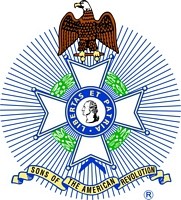
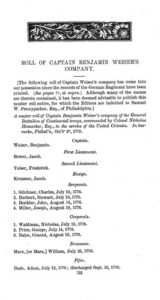
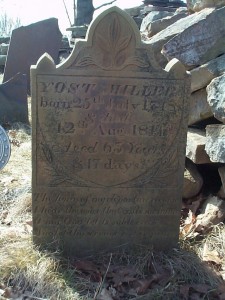
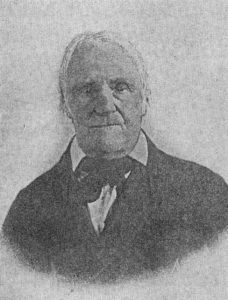
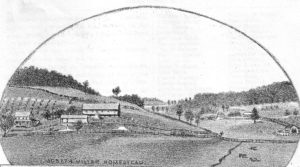

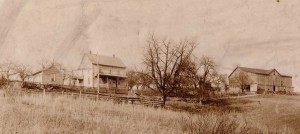
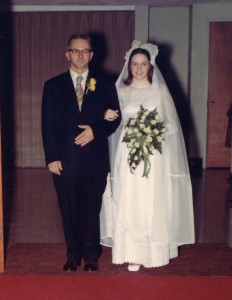
Thank you very much for making your research available like this. Joseph and Yost Miller are also my ancestors, via Yost and Marie’s daughter Barbara. I was getting ready to write up what I found several years ago, but decided to see if there is anything new — so am delighted to find this! Do you have a preference for how I document you as the source?
Beverly,
I’ve taken the liberty to write you via e-mail and suggested any standard citation format. They can be found by Googling that phrase. As a former English teacher, I’d caution you to just be consistent, but depending on your audience, you needn’t be too exact with the format, i.e. name order, abbreviations, etc. They’re constantly changing anyway. When you get to be a professional, your “highly paid” editor will take care of these things for you! That’s just my opinion as a blogger.
Larry
Thanks, Larry!
I too am a direct decedent of Yost Miller. I have an original copy of the Brief History of Yost and Jerimiah Miller and appreciate your detailed history of the family
Thanks for the kind words, Mark. Glad to hear from so many of Yost and Jeremiah’s descendants.
Larry
FYI, If anyone is looking for a .pdf version of A Brief history of Yost (Joseph) and Jeremiah Miller and Their Descendants by William H. Miller, it has now been uploaded to Archive.org:
https://archive.org/details/briefhistoryofyo00mill
Wow, Matt, that looks great to me! Despite being a page-after-page of folks most of us don’t know, the introductory material on each branch is fascinating. Just copy what you want or need and check back later for more. Thanks for sharing.
Larry